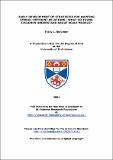Files in this item
Early development of strategies for mapping symbol-referent relations : what do young children understand about scale models?
Item metadata
| dc.contributor.advisor | Gomez, Juan-Carlos | |
| dc.contributor.author | Solomon, Tracy L. | |
| dc.coverage.spatial | viii, 188 p. | en_US |
| dc.date.accessioned | 2018-04-16T13:00:50Z | |
| dc.date.available | 2018-04-16T13:00:50Z | |
| dc.date.issued | 2001-11 | |
| dc.identifier.uri | https://hdl.handle.net/10023/13142 | |
| dc.description.abstract | The research reported here investigated the nature of young children's understanding of a novel symbol-a scale model. Children witnessed the hiding of a small toy in a scale model of a room and were then required to search for an analogous larger toy that had been surreptitiously hidden in the actual room. At issue was whether children succeed by attending to the target location (object strategy), to the spatial location of the target location (spatial strategy), or to both types of information. It has been suggested that at three years of age (the age at which children first succeed on the task) children succeed by recognizing the correspondence between analogous objects in the two spaces (Bence & Presson, 1997; Blades & Cooke, 1994; Perner, 1991; Lillard, 1993) but that an understanding of the model as a whole as a representation of the room necessitates also attending to the spatial relations between the objects (Perner, 1991; Lillard, 1993). In five Experiments, children participated in versions of the model task that varied in the type of information (object and/or spatial) available to solve the task. The results revealed that although, in general, children rely primarily on the identity of the individual objects to find the hidden toy, the spatial relations between the objects may also influence task success. Furthermore, there was strong evidence of individual differences in children's strategies which appeared to be linked to sex, with girls attending primarily to the identity of the objects and boys demonstrating a fledgling ability to approach the model spatially. Some children also appeared to label the target object but the labeling strategy could not account for girls' tendency to attend to the objects more than boys. It is suggested that characterizations of an abrupt shift between three and four years of age in the ability to interpret the model as a whole as a representation of the room may be misleading. There may be multiple developmental routes to the gradual acquisition of an explicit understanding of a scale model as a symbol for the space it is intended to represent. | en_US |
| dc.language.iso | en | en_US |
| dc.publisher | University of St Andrews | |
| dc.subject.lcc | BF723.C5S7 | |
| dc.subject.lcsh | Cognition in children. | en |
| dc.subject.lcsh | Space perception. | en |
| dc.subject.lcsh | Problem solving in children. | en |
| dc.title | Early development of strategies for mapping symbol-referent relations : what do young children understand about scale models? | en_US |
| dc.type | Thesis | en_US |
| dc.type.qualificationlevel | Doctoral | en_US |
| dc.type.qualificationname | PhD Doctor of Philosophy | en_US |
| dc.publisher.institution | The University of St Andrews | en_US |
This item appears in the following Collection(s)
Items in the St Andrews Research Repository are protected by copyright, with all rights reserved, unless otherwise indicated.

